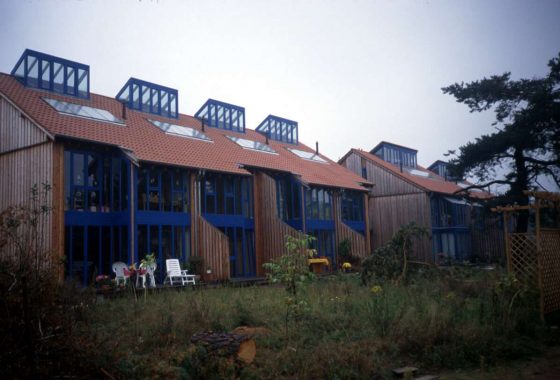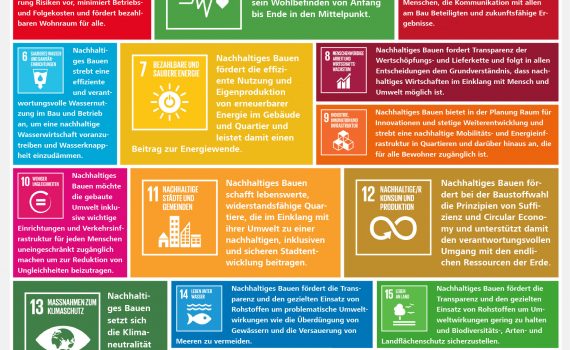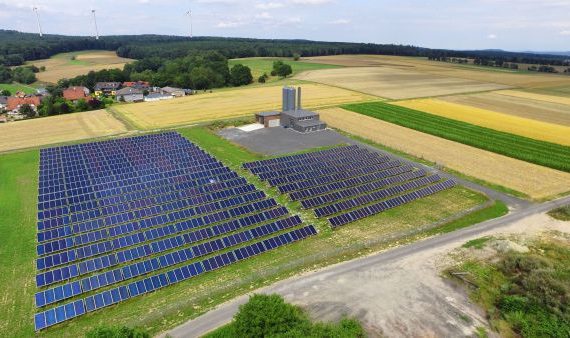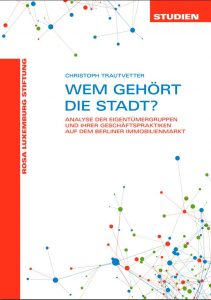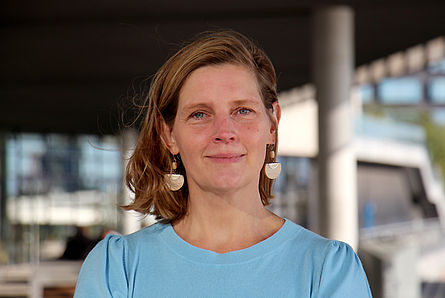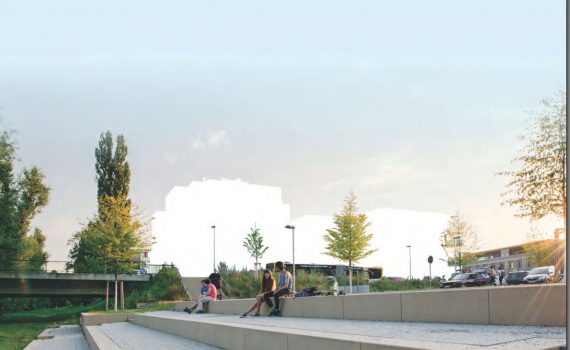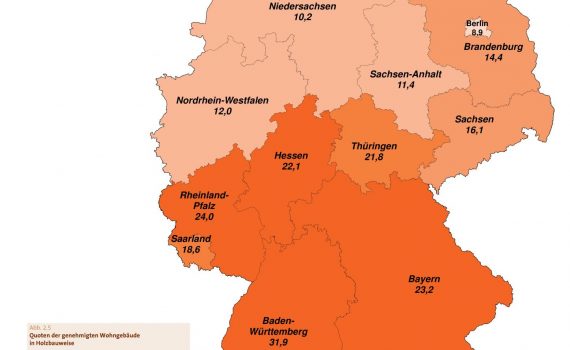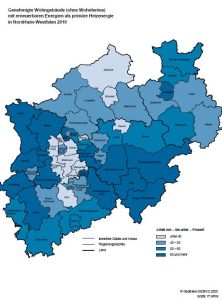Kategorie für Blog: Media
 The German Sustainable Building Council (DGNB e.V.) has published a new report explaining how buildings can contribute to the United Nations' global sustainability goals. The publication compares the 17 Sustainable Development Goals (SDGs) with the potential influence of sustainable planning and construction. Architects and planners, as well as building owners and municipalities, are thus provided with orientation as to how they can meaningfully become active in terms of sustainable development. The report also offers a comparison of the SDGs with the criteria of various DGNB certification systems. This shows: Up to 15 of the 17 SDGs are addressed in the context of the DGNB certification of a building project.
The German Sustainable Building Council (DGNB e.V.) has published a new report explaining how buildings can contribute to the United Nations' global sustainability goals. The publication compares the 17 Sustainable Development Goals (SDGs) with the potential influence of sustainable planning and construction. Architects and planners, as well as building owners and municipalities, are thus provided with orientation as to how they can meaningfully become active in terms of sustainable development. The report also offers a comparison of the SDGs with the criteria of various DGNB certification systems. This shows: Up to 15 of the 17 SDGs are addressed in the context of the DGNB certification of a building project.
 With the portal https://energiewendedörfer.de the University of Kassel and Georg-August-Universität Göttingen will present the initial results from the joint project "Innovative concepts and business models for sustainable bioenergy villages - climate-friendly, democratic, citizen-centred". In particular, concepts are being developed for bioenergy and biogas plants that can enable continued economic operation after the current 20-year EEG phase.
With the portal https://energiewendedörfer.de the University of Kassel and Georg-August-Universität Göttingen will present the initial results from the joint project "Innovative concepts and business models for sustainable bioenergy villages - climate-friendly, democratic, citizen-centred". In particular, concepts are being developed for bioenergy and biogas plants that can enable continued economic operation after the current 20-year EEG phase.
 The ecological model settlement on a former barracks site in Munich sets new standards in timber construction. Various timber construction methods and building types up to seven storeys are being tested side by side in eight building projects with the aim of a final scientific evaluation. Timber frame, timber frame and timber hybrid construction methods are being used.
The ecological model settlement on a former barracks site in Munich sets new standards in timber construction. Various timber construction methods and building types up to seven storeys are being tested side by side in eight building projects with the aim of a final scientific evaluation. Timber frame, timber frame and timber hybrid construction methods are being used.
Around 60 percent of the resources used in Berlin are processed in the construction industry. This contrasts with millions of tonnes of building rubble and construction site waste. Every year, 2.2 million tons of primary raw materials are already saved in civil engineering and building construction in Berlin through the use of quality-assured secondary raw materials. But Berlin does not intend to stop there. By 2030, a further 1.4 million tonnes of primary materials are to be replaced by secondary raw materials each year.
 Since April 2020, the Öko-Institut has been conducting research into how urban neighbourhoods can be sustainably transformed, using two neighbourhoods in the swarming city of Darmstadt as examples, in the project Transformative Strategies for Integrated Neighbourhood Development (TRASIQ 2). The Federal Ministry of Education and Research is funding the project, which is led by the Öko-Institut and involves the City of Darmstadt, the Institute for Regional and Urban Development Research (ILS) and the "Team Ewen" agency.
Since April 2020, the Öko-Institut has been conducting research into how urban neighbourhoods can be sustainably transformed, using two neighbourhoods in the swarming city of Darmstadt as examples, in the project Transformative Strategies for Integrated Neighbourhood Development (TRASIQ 2). The Federal Ministry of Education and Research is funding the project, which is led by the Öko-Institut and involves the City of Darmstadt, the Institute for Regional and Urban Development Research (ILS) and the "Team Ewen" agency.
Mobility, heat and living space
The project focuses on the research topics of mobility, heat supply and efficient use of living space. Heat supply is an important key to climate-friendly living. How and where, for example, can district heating be expanded in existing properties? How can we increase the share of renewable energies in the heat supply? The size of the living space also contributes to how environmentally friendly a person lives. What needs to be done to ensure that people have the living space they need in their particular phase of life through intelligent apartment swaps? How can neighbourhoods be redesigned so that residents can organise their mobility ecologically? With the gradual dismantling of ten particularly climate-damaging subsidies in the energy, transport and agricultural sectors, Germany could generate up to 46 billion euros in revenue annually. This is the result of a new study by the "Forum Ökologisch-Soziale Marktwirtschaft" commissioned by Greenpeace.
With the gradual dismantling of ten particularly climate-damaging subsidies in the energy, transport and agricultural sectors, Germany could generate up to 46 billion euros in revenue annually. This is the result of a new study by the "Forum Ökologisch-Soziale Marktwirtschaft" commissioned by Greenpeace.
 Dr. Kirsten David, a researcher at HafenCity University (HCU) Hamburg, has developed an innovative method for determining rent increases after energy efficiency measures: By means of functional cost splitting, rent increases become appropriate and comprehensible. The planning of the energetic measures is also ecologically optimized. For her dissertation entitled "Functional Cost Splitting for the Determination of Rent Increases after Energy Efficiency Measures", the scientist today receives the "BUND Research Award 2020". With the research award, the Bund für Umwelt- und Naturschutz (BUND) honors scientific work on sustainable development.
Dr. Kirsten David, a researcher at HafenCity University (HCU) Hamburg, has developed an innovative method for determining rent increases after energy efficiency measures: By means of functional cost splitting, rent increases become appropriate and comprehensible. The planning of the energetic measures is also ecologically optimized. For her dissertation entitled "Functional Cost Splitting for the Determination of Rent Increases after Energy Efficiency Measures", the scientist today receives the "BUND Research Award 2020". With the research award, the Bund für Umwelt- und Naturschutz (BUND) honors scientific work on sustainable development.
 Glaciers are melting, sea levels are rising, heat waves and heavy rainfall are increasing: The consequences of climate change are visible and tangible worldwide, and the window of opportunity to act is shrinking. In order to significantly limit the global effects of climate change, the emission of greenhouse gases on earth must be drastically reduced. The agreement reached by the international community in Paris in 2015 sets the goal of limiting global warming to well below 2 degrees Celsius, but preferably to 1.5 degrees Celsius. Now, the Wuppertal Institute presented a study with possible cornerstones that can help to achieve the 1.5 degree target by 2035. The study shows that a climate-neutral energy system by 2035 is very ambitious, but in principle feasible, provided that all possible strategies from today's perspective are bundled. This requires, above all, bringing forward and intensifying measures that are described in many studies as necessary to achieve greenhouse gas neutrality by 2050.
Glaciers are melting, sea levels are rising, heat waves and heavy rainfall are increasing: The consequences of climate change are visible and tangible worldwide, and the window of opportunity to act is shrinking. In order to significantly limit the global effects of climate change, the emission of greenhouse gases on earth must be drastically reduced. The agreement reached by the international community in Paris in 2015 sets the goal of limiting global warming to well below 2 degrees Celsius, but preferably to 1.5 degrees Celsius. Now, the Wuppertal Institute presented a study with possible cornerstones that can help to achieve the 1.5 degree target by 2035. The study shows that a climate-neutral energy system by 2035 is very ambitious, but in principle feasible, provided that all possible strategies from today's perspective are bundled. This requires, above all, bringing forward and intensifying measures that are described in many studies as necessary to achieve greenhouse gas neutrality by 2050.
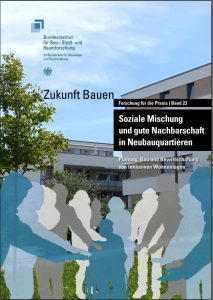 The Institute for Urban Planning and Social Research WEEBER+PARTNER (Stuttgart) examined 16 case studies and interviewed responsible persons in municipal, cooperative and private housing companies. The projects are characterized by a wide range of planning and construction approaches. According to the study, social diversity requires structural diversity: Rental, social and owner-occupied apartments of different sizes and with diverse layouts were created in the new housing quarters. They are socially mixed - even within buildings - with the respective proportions in the neighbourhood being derived from local requirements. The new quarters also offer space for communal forms of living, for example for older people and those in need of care. And they are characterised by an attractively designed and green residential environment. Concept awards promote the planning and implementation of such projects: Through them, plots of land are not allocated according to the highest price, but for the best concept.
The Institute for Urban Planning and Social Research WEEBER+PARTNER (Stuttgart) examined 16 case studies and interviewed responsible persons in municipal, cooperative and private housing companies. The projects are characterized by a wide range of planning and construction approaches. According to the study, social diversity requires structural diversity: Rental, social and owner-occupied apartments of different sizes and with diverse layouts were created in the new housing quarters. They are socially mixed - even within buildings - with the respective proportions in the neighbourhood being derived from local requirements. The new quarters also offer space for communal forms of living, for example for older people and those in need of care. And they are characterised by an attractively designed and green residential environment. Concept awards promote the planning and implementation of such projects: Through them, plots of land are not allocated according to the highest price, but for the best concept.
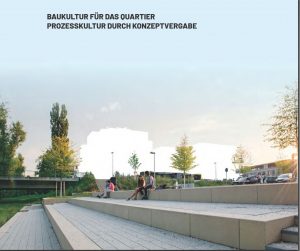 Conceptual procedures are increasingly establishing themselves as a further instrument of municipal land policy for locations with development potential. Here, the property is not allocated according to the highest price, but according to the concept that promises the most sustainable approaches to the further development of the neighbourhood. In this way, the procedures offer municipalities approaches to solving two current and urgent problems: the need for high-quality urban development and affordable housing.
Conceptual procedures are increasingly establishing themselves as a further instrument of municipal land policy for locations with development potential. Here, the property is not allocated according to the highest price, but according to the concept that promises the most sustainable approaches to the further development of the neighbourhood. In this way, the procedures offer municipalities approaches to solving two current and urgent problems: the need for high-quality urban development and affordable housing.
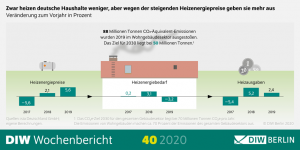 Annual DIW Heat Monitor based on data from energy service provider ista Deutschland GmbH: Heating energy demand in residential buildings declines again for the first time since 2015 - Rising prices, however, cause heating expenditure to increase by 2.4 percent - CO2emissions have fallen by 21 percent overall since 2010, but by only 2.6 percent when adjusted for temperature - Energy-efficient renovation in residential buildings almost stagnant
Annual DIW Heat Monitor based on data from energy service provider ista Deutschland GmbH: Heating energy demand in residential buildings declines again for the first time since 2015 - Rising prices, however, cause heating expenditure to increase by 2.4 percent - CO2emissions have fallen by 21 percent overall since 2010, but by only 2.6 percent when adjusted for temperature - Energy-efficient renovation in residential buildings almost stagnant
Jury statement: "The WIR neighbourhood in Berlin is characterised not only by its high energy efficiency (KfW 40 standard) and the use of wood as a renewable raw material for the building construction, but also by the collaborative planning process, which led to different housing concepts and the integration of different social communities. Communal areas and shared facilities such as a residents' workshop, swimming pool, neighbourhood square and daycare centre enable a lively and diverse neighbourhood. This also includes a dementia residential community as well as organisations for youth work and refugee groups. The five apartment blocks were realised with a timber frame construction and the façade in timber panel construction. This resulted in flexible floor plans that offer good conversion options."
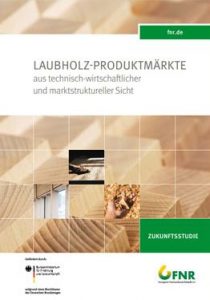 A study funded by the Federal Ministry of Agriculture determined the potential of hardwood as a substitute for coniferous wood. The results of the study are now available in a brochure published by the Fachagentur Nachwachsende Rohstoffe e. V. (FNR). There is considerable potential for hardwood to be used in industrial timber, but it cannot yet be a substitute for softwood in construction
A study funded by the Federal Ministry of Agriculture determined the potential of hardwood as a substitute for coniferous wood. The results of the study are now available in a brochure published by the Fachagentur Nachwachsende Rohstoffe e. V. (FNR). There is considerable potential for hardwood to be used in industrial timber, but it cannot yet be a substitute for softwood in construction
Short video about the DGNB system for districts in the 2020 version. Which criteria are relevant? Which types of neighbourhoods can be certified according to DGNB?
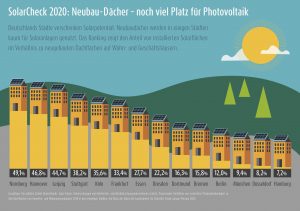 Good news for the PV industry: The solar cap will be abolished and solar expansion will be further promoted. The photovoltaic potential in Germany is enormous - especially when it comes to using roof space on new buildings. The new LichtBlick SolarCheck now shows in detail how well the 14 largest German cities are currently exploiting this potential. Enormous differences are revealed: While Nuremberg (49.1%) and Hanover (46.8%) exploit almost half of their potential, Munich and Düsseldorf do not even reach the 10 percent hurdle. The absolute taillight: the Hanseatic city of Hamburg with only 7.2 percent - one more reason for the solar obligation for new buildings planned by the mayor's office.
Good news for the PV industry: The solar cap will be abolished and solar expansion will be further promoted. The photovoltaic potential in Germany is enormous - especially when it comes to using roof space on new buildings. The new LichtBlick SolarCheck now shows in detail how well the 14 largest German cities are currently exploiting this potential. Enormous differences are revealed: While Nuremberg (49.1%) and Hanover (46.8%) exploit almost half of their potential, Munich and Düsseldorf do not even reach the 10 percent hurdle. The absolute taillight: the Hanseatic city of Hamburg with only 7.2 percent - one more reason for the solar obligation for new buildings planned by the mayor's office.
Am 20. Juni ist kalendarischer Sommeranfang und vielerorts sind schon jetzt Trockenheit und niedrige Wasserstände in den Flüssen an der Tagesordnung, die Gewässer in Deutschland sind nicht gegen die Auswirkungen des Klimawandels gerüstet. Angesichts der verheerenden Zustände vieler Gewässer in Deutschland fordert der BUND einen Paradigmenwechsel im Umgang mit unseren Gewässern: Oberstes Prinzip in Zeiten des Klimawandels muss sein, Wasser in der Landschaft zu halten und Bächen und Flüssen ihre natürliche Dynamik innerhalb ihrer Auen zurückzugeben. Nur knapp acht Prozent der Flüsse und Bäche in Deutschland erreichen den von der europäischen Wasserrahmenrichtlinie geforderten guten ökologischen Zustand. Knapp 40 Prozent der oberirdischen Gewässer sind europaweit durch vielfältige Stressoren wie Klimawandel, Nährstoffeinträge durch die Landwirtschaft oder Begradigungen belastet. "Wir heizen die Erde weiter auf, gleichzeitig entwässern wir die Landschaft. Deshalb ist es keine Überraschung, dass es unseren heimischen Gewässern so schlecht geht", betont Olaf Bandt, Vorsitzender des BUND, mit Blick auf eine aktuelle Auswertung des BUND zu den Auswirkungen des Klimawandels auf Gewässer.
Lecture "Can we build our way out of the climate crisis?" from 16 April 2020
Among other things, Schellnhuber calls for "prompt measures to achieve the two-degree target, above all by switching from fossil to renewable energy sources and replacing finite building materials with wood and renewable raw materials."
 The discussion about climate change and the growing demand for living space have increasingly brought timber construction into the focus of planners, architects and developers over the past year. After all, sustainable timber construction can make a significant contribution to climate protection and the creation of living space. The increased interest in timber construction is also reflected in the industry figures: the turnover of companies grew by 7 percent in 2019 compared to the previous year, the number of employees increased from around 68,000 to around 70,000 and the timber construction rate continued to grow in both residential (new construction) and non-residential (new construction) construction.
The discussion about climate change and the growing demand for living space have increasingly brought timber construction into the focus of planners, architects and developers over the past year. After all, sustainable timber construction can make a significant contribution to climate protection and the creation of living space. The increased interest in timber construction is also reflected in the industry figures: the turnover of companies grew by 7 percent in 2019 compared to the previous year, the number of employees increased from around 68,000 to around 70,000 and the timber construction rate continued to grow in both residential (new construction) and non-residential (new construction) construction.
 Berlin/Cologne. Climate protection and adaptation to the consequences of climate change will become increasingly important for cities. This is one of the findings of the survey of (Lord) Mayors of large German cities* conducted by the German Institute of Urban Affairs in January and February 2020. Almost two-thirds of the respondents named climate protection as an important municipal issue for the future. This means that the number of mayors who attribute an increase in importance to this field of municipal policy action has more than tripled compared to the previous year. Future surveys will show how strongly this result was influenced by the protests of the 'Fridays for Future' movement.
Berlin/Cologne. Climate protection and adaptation to the consequences of climate change will become increasingly important for cities. This is one of the findings of the survey of (Lord) Mayors of large German cities* conducted by the German Institute of Urban Affairs in January and February 2020. Almost two-thirds of the respondents named climate protection as an important municipal issue for the future. This means that the number of mayors who attribute an increase in importance to this field of municipal policy action has more than tripled compared to the previous year. Future surveys will show how strongly this result was influenced by the protests of the 'Fridays for Future' movement.
 Eine Studie des Forums Ökologisch-Soziale Marktwirtschaft im Auftrag von Greenpeace (März 2020).
Durch die Corona-Krise wird der Staat Soforthilfen und weitreichende Konjunkturmaßnahmen historischen Ausmaßes umsetzen. Während Gesundheit und die kurzfristige Unterstützung von Arbeitnehmer*innen und Unternehmen in den Fokus rücken, dürfen die Fehler vergangener Wirtschaftskrisen nicht wiederholt werden. Die geplanten Hilfen für einen wirtschaftlichen Neustart können die Weichen stellen für die notwendige Transformation. Anhand einiger Beispiele wird illustriert, wie kurzfristige wirtschaftliche Unterstützung mit langfristigen gesellschaftlichen Prioritäten in Einklang gebracht werden können.
Eine Studie des Forums Ökologisch-Soziale Marktwirtschaft im Auftrag von Greenpeace (März 2020).
Durch die Corona-Krise wird der Staat Soforthilfen und weitreichende Konjunkturmaßnahmen historischen Ausmaßes umsetzen. Während Gesundheit und die kurzfristige Unterstützung von Arbeitnehmer*innen und Unternehmen in den Fokus rücken, dürfen die Fehler vergangener Wirtschaftskrisen nicht wiederholt werden. Die geplanten Hilfen für einen wirtschaftlichen Neustart können die Weichen stellen für die notwendige Transformation. Anhand einiger Beispiele wird illustriert, wie kurzfristige wirtschaftliche Unterstützung mit langfristigen gesellschaftlichen Prioritäten in Einklang gebracht werden können.
 In research, neighbourhoods have been recognised as an important level of action for climate protection. For this reason, the BMBF, BMU and the Federal Ministry of Building and Transport have funded several research projects on sustainable neighbourhoods, which are now being worked on. The consensus of the research projects presented and the funding bodies is that it is important to research neighbourhood concepts for a climate-friendly heat and electricity supply as well as an environmentally friendly mobility offer in an economical way" and "to link the individual elements in the sense of a functioning sector coupling in a meaningful way."
The focus articles in the "Ecological Economy 3/2019" issue highlight the potential of the neighbourhood approach for the implementation of climate protection measures, but also present best practice examples and discuss feasibility in practice.
In research, neighbourhoods have been recognised as an important level of action for climate protection. For this reason, the BMBF, BMU and the Federal Ministry of Building and Transport have funded several research projects on sustainable neighbourhoods, which are now being worked on. The consensus of the research projects presented and the funding bodies is that it is important to research neighbourhood concepts for a climate-friendly heat and electricity supply as well as an environmentally friendly mobility offer in an economical way" and "to link the individual elements in the sense of a functioning sector coupling in a meaningful way."
The focus articles in the "Ecological Economy 3/2019" issue highlight the potential of the neighbourhood approach for the implementation of climate protection measures, but also present best practice examples and discuss feasibility in practice.
3:00 min. Published: 12.03.2020
The non-profit association GermanZero has taken the initiative and put together a comprehensive package of measures - now it is to be implemented. The initiative is seeking support with the video.
Joining us are:
Rike Schmid, Rezo, Jan Josef Liefers, Christoph Kramer, Carolin Kebekus, Charly Hübner, Jan Delay, Markus Kavka, Katrin Ingendoh, Andreas Rettig, Nik Xhelilaj, Rewinside, Mark Zwinz, Anneke Kim Sarnau, Emma Bading, Volker Bruch, Lars Jessen, Peter Jordan, Karoline Eichhorn, Wanja Mues, Jan Plewka, Marlis Heppeler, Steffen Weinhold, Katharina Wackernagel, Christine Urspruch, Raul Krauthausen, Rocko Schamoni, Mojib Latif, Joko Winterscheidt, Stephan Schad, André Schürrle, Moritz Vierboom, Friederike Kempter, Matthias Willenbacher, Axel Prahl, Maria Ketikidou, Mirella Precek, Jan Georg Schütte, Bjarne Mädel, Pheline Roggan, Andreas Altenburg, Lisa Maria Potthoff, Désirée von Delft, Peter Smits, Gustav Peter Wöhler, Ruth Toma, Maren Eggert, Benjamin Sadler, Fettes Brot, Jonas Nay, Stephan Kampwirth, Miriam Stein, Lea van Acken

